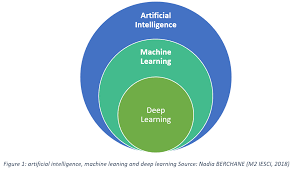Understanding AI and Machine Learning: Transforming the Future
Artificial Intelligence (AI) and Machine Learning (ML) are two of the most transformative technologies of our time. They are reshaping industries, driving innovation, and changing how we interact with the world. This article explores what AI and ML are, how they differ, and their impact on various sectors.
What is Artificial Intelligence?
Artificial Intelligence refers to the simulation of human intelligence in machines designed to think and act like humans. These systems can perform tasks such as problem-solving, learning from experience, understanding language, and recognizing patterns. AI can be categorized into two types: narrow AI, which is designed for specific tasks like facial recognition or internet searches, and general AI, which possesses the ability to perform any intellectual task that a human can do.
What is Machine Learning?
Machine Learning is a subset of AI that focuses on building systems that learn from data to improve their performance over time without being explicitly programmed. It involves algorithms that identify patterns within large datasets and make predictions or decisions based on this analysis. ML is widely used in applications such as recommendation systems, fraud detection, and predictive analytics.
The Relationship Between AI and ML
While often used interchangeably, AI and ML are distinct yet interconnected fields. Machine Learning provides the statistical backbone for many AI applications by enabling systems to learn autonomously from data inputs. In essence, all machine learning is artificial intelligence, but not all artificial intelligence involves machine learning.
Applications of AI and ML
- Healthcare: AI-driven tools assist in diagnosing diseases more accurately by analyzing medical images or genetic information. Machine learning models predict patient outcomes or personalize treatment plans based on historical data.
- Finance: In finance, algorithms powered by machine learning detect fraudulent transactions by identifying unusual patterns in spending behavior.
- Automotive: Self-driving cars use a combination of sensors, cameras, and deep learning algorithms to navigate roads safely without human intervention.
- E-commerce: Retailers leverage recommendation engines powered by machine learning to suggest products tailored to individual consumer preferences.
The Future Impact of AI and ML
The potential impact of these technologies is vast as they continue evolving at an unprecedented pace. From automating routine tasks across industries to enhancing decision-making processes through predictive analytics—AI & ML hold promise for significant economic growth while also posing ethical considerations around privacy protection or job displacement due automation advances.
Conclusion
The rise of artificial intelligence coupled with advances in machine learning stands poised not only revolutionize existing paradigms but also create entirely new possibilities previously thought impossible before now—a testament humanity’s relentless pursuit knowledge-driven progress toward better tomorrows ahead!
7 Essential Tips for Mastering AI and Machine Learning Techniques
- Understand the problem you are trying to solve before choosing an AI or machine learning approach.
- Clean and preprocess your data to ensure high-quality input for your models.
- Choose the right algorithm that best fits your data and problem at hand.
- Regularly evaluate and fine-tune your models to improve their performance over time.
- Be mindful of bias in your data and algorithms to ensure fair and ethical outcomes.
- Stay updated with the latest trends and advancements in AI and machine learning technologies.
- Collaborate with domain experts to gain deeper insights into the problem domain.
Understand the problem you are trying to solve before choosing an AI or machine learning approach.
Before diving into an AI or machine learning project, it’s crucial to thoroughly understand the problem you’re trying to solve. Clearly defining the problem will guide you in selecting the most appropriate AI or ML approach, as different techniques are suited for different types of challenges. By identifying the specific goals and constraints of your problem, you can better assess which algorithms and models will be effective. This understanding also helps in determining the data requirements and evaluating potential outcomes. Without a clear grasp of the problem, there’s a risk of misapplying technology, leading to inefficient solutions or wasted resources. Therefore, investing time in problem analysis is a critical first step toward successful AI and machine learning implementation.
Clean and preprocess your data to ensure high-quality input for your models.
Cleaning and preprocessing data is a crucial step in the AI and machine learning workflow, as it ensures that models receive high-quality input, leading to more accurate and reliable results. Raw data often contains noise, inconsistencies, or missing values that can negatively impact the performance of algorithms. By thoroughly cleaning the data—removing duplicates, filling in missing values, and correcting errors—one can significantly enhance the model’s ability to learn meaningful patterns. Preprocessing steps such as normalization, scaling, and encoding categorical variables further refine the dataset, aligning it with the specific requirements of different machine learning models. Ultimately, investing time in these preliminary stages not only improves model performance but also contributes to more robust and trustworthy insights.
Choose the right algorithm that best fits your data and problem at hand.
Choosing the right algorithm for your AI and machine learning projects is crucial to achieving accurate and meaningful results. Each algorithm has its strengths and weaknesses, and their effectiveness can vary depending on the nature of your data and the specific problem you are trying to solve. For instance, if you’re dealing with a classification problem with a large dataset, algorithms like support vector machines or decision trees might be suitable. On the other hand, for tasks involving natural language processing, neural networks or recurrent neural networks could be more effective. It’s essential to understand the characteristics of your data—such as its size, quality, and complexity—and align these with an algorithm that can handle these attributes efficiently. By carefully selecting an appropriate algorithm, you ensure that your model not only learns effectively but also performs optimally when applied to real-world scenarios.
Regularly evaluate and fine-tune your models to improve their performance over time.
Regularly evaluating and fine-tuning AI and machine learning models is crucial for maintaining and improving their performance over time. As data evolves and new patterns emerge, models can become outdated or less accurate if not periodically assessed. By routinely analyzing model outputs and comparing them against real-world results, developers can identify areas where performance may be lacking. Fine-tuning involves adjusting parameters or incorporating new data to enhance accuracy and efficiency. This continuous process ensures that models remain relevant, reliable, and capable of delivering optimal results in dynamic environments. Regular evaluation also helps in identifying biases or errors early, allowing for timely corrections that uphold the integrity of the model’s predictions.
Be mindful of bias in your data and algorithms to ensure fair and ethical outcomes.
When developing AI and machine learning models, it’s crucial to be mindful of bias in both the data and algorithms to ensure fair and ethical outcomes. Bias can arise from unrepresentative datasets or from historical prejudices embedded in the data, leading to skewed results that may disadvantage certain groups. This can perpetuate existing inequalities and result in unfair treatment or decisions. To mitigate this risk, it’s important to carefully curate diverse and representative datasets, regularly audit algorithms for biased behavior, and implement fairness constraints during model training. By taking these steps, developers can create more equitable AI systems that serve all users justly.
Stay updated with the latest trends and advancements in AI and machine learning technologies.
Staying updated with the latest trends and advancements in AI and machine learning technologies is crucial for anyone involved in or interested in these fields. As AI and ML rapidly evolve, new algorithms, tools, and applications emerge that can significantly impact industries and everyday life. Keeping abreast of these developments ensures that individuals and businesses can leverage the most current innovations to enhance efficiency, drive growth, and maintain a competitive edge. Regularly engaging with industry news, attending conferences, participating in webinars, and joining professional networks are effective ways to stay informed about cutting-edge research and breakthroughs. By doing so, one can better anticipate future trends and adapt strategies accordingly to harness the full potential of AI and machine learning.
Collaborate with domain experts to gain deeper insights into the problem domain.
Collaborating with domain experts is crucial when working with AI and machine learning, as it provides deeper insights into the specific problem domain. These experts possess specialized knowledge and experience that can help identify key variables, interpret data more accurately, and guide the development of models tailored to real-world applications. By working closely with these professionals, data scientists and engineers can ensure that their AI solutions are not only technically sound but also practically relevant. This collaboration leads to more effective models, improved decision-making processes, and ultimately, solutions that are better aligned with industry needs and challenges.


